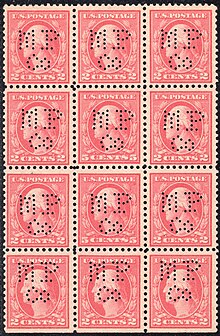Perfin: Difference between revisions
m Bot: Migrating 5 interwiki links, now provided by Wikidata on d:q1760241 (Report Errors) |
m →Postal stationery: link added |
||
| Line 17: | Line 17: | ||
==Postal stationery== |
==Postal stationery== |
||
In addition to stamps [[postal stationery]] envelopes, [[postcard]]s,<ref>John Barker, ''Perfins through Postal Stationery - Postcards'', The Postal Stationery Society Journal Vol 14 No 4 p15</ref> and [[newspaper wrapper]]s<ref>John Barker, ''Perfins through Postal Stationery - Newspaper Wrappers'', The Postal Stationery Society Journal Vol 15 No 2 p11 & No 3 p15</ref> were perfinned. |
In addition to stamps [[postal stationery]] envelopes, [[postcard]]s,<ref>John Barker, ''Perfins through Postal Stationery - Postcards'', The [[Postal Stationery Society]] Journal Vol 14 No 4 p15</ref> and [[newspaper wrapper]]s<ref>John Barker, ''Perfins through Postal Stationery - Newspaper Wrappers'', The Postal Stationery Society Journal Vol 15 No 2 p11 & No 3 p15</ref> were perfinned. |
||
==Perfinned postal orders== |
==Perfinned postal orders== |
||
Revision as of 16:32, 10 April 2013





In philately, a perfin is a stamp that has had initials or a name perforated across it to discourage theft. The name is a contraction of perforated initials or perforated insignia. They are also sometimes called SPIFS (Stamps Perforated with Initials of Firms and Societies).[1] Perfins are no longer widely used since the introduction of franking machines or postage meters.
History
Great Britain was the first country to use perfins in 1868.[2] In Britain unused postage stamps could be redeemed for cash at the post office, but a perforated stamp had obviously been stolen so the use of perfins gave organisations better security over their postage.
Officially prepared perfins
A number of countries have perforated stamps to denote official mail. Denmark punctured stamps for use by the Danish Home Guard.[3] The United States has punctured stamps for use by various Federal organisations and Australian states such as Victoria and Queensland used perfins widely on their stamps.
Collecting perfins
Formerly considered damaged and not worth collecting, perforated postage stamps are now highly sought after by specialist collectors. It is often difficult to identify the originating uses of individual perfins because there are usually no identifying features, for instance the Kodak company used a simple K as their perfin, but on its own a stamp perforated K could have been used by several other users. A K perfin still affixed to a cover that has some company identifying feature, like the company name, address, or even a postmark or cancellation of a town where the company had offices, enhances such a perfin.
Postal stationery
In addition to stamps postal stationery envelopes, postcards,[4] and newspaper wrappers[5] were perfinned.
Perfinned postal orders
Perfinned British postal orders were used to pay out winning bets on the football pools and these postal orders are very sought after by collectors.
Specimen stamps
Specimen stamps have often been perfinned with the word specimen to denote their status.
References
- ^ "Baadke, Michael; Why does my stamp have a lot of holes in it? in Linns.com Refresher Course section".
- ^ Toke Nørby. The Story about the SPIFS and PERFINs — See Part 4. The Authorizations to Perforate Stamps.
- ^ Brug af frimærker i Hjemmeværnet.
- ^ John Barker, Perfins through Postal Stationery - Postcards, The Postal Stationery Society Journal Vol 14 No 4 p15
- ^ John Barker, Perfins through Postal Stationery - Newspaper Wrappers, The Postal Stationery Society Journal Vol 15 No 2 p11 & No 3 p15
Clubs
- German Perfin Association - In German
- The Perfins Club - United States Perfins
- The Perfin Society - Great Britain Perfins
